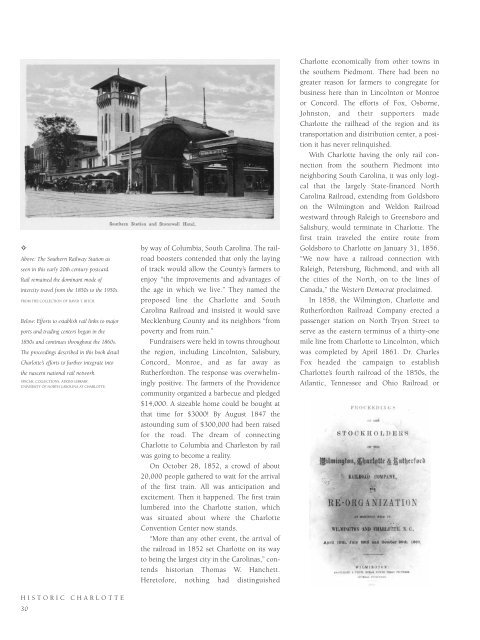Historic Charlotte
An illustrated history of the City of Charlotte and the Mecklenburg County area, paired with the histories of companies, families and organizations that make the region great.
An illustrated history of the City of Charlotte and the Mecklenburg County area, paired with the histories of companies, families and organizations that make the region great.
You also want an ePaper? Increase the reach of your titles
YUMPU automatically turns print PDFs into web optimized ePapers that Google loves.
✧<br />
Above: The Southern Railway Station as<br />
seen in this early 20th century postcard.<br />
Rail remained the dominant mode of<br />
intercity travel from the 1850s to the 1950s.<br />
FROM THE COLLECTION OF DAVID T. RITCH.<br />
Below: Efforts to establish rail links to major<br />
ports and trading centers began in the<br />
1850s and continues throughout the 1860s.<br />
The proceedings described in this book detail<br />
<strong>Charlotte</strong>’s efforts to further integrate into<br />
the nascent national rail network.<br />
SPECIAL COLLECTIONS, ATKINS LIBRARY,<br />
UNIVERSITY OF NORTH CAROLINA AT CHARLOTTE.<br />
HISTORIC CHARLOTTE<br />
30<br />
by way of Columbia, South Carolina. The railroad<br />
boosters contended that only the laying<br />
of track would allow the County’s farmers to<br />
enjoy “the improvements and advantages of<br />
the age in which we live.” They named the<br />
proposed line the <strong>Charlotte</strong> and South<br />
Carolina Railroad and insisted it would save<br />
Mecklenburg County and its neighbors “from<br />
poverty and from ruin.”<br />
Fundraisers were held in towns throughout<br />
the region, including Lincolnton, Salisbury,<br />
Concord, Monroe, and as far away as<br />
Rutherfordton. The response was overwhelmingly<br />
positive. The farmers of the Providence<br />
community organized a barbecue and pledged<br />
$14,000. A sizeable home could be bought at<br />
that time for $3000! By August 1847 the<br />
astounding sum of $300,000 had been raised<br />
for the road. The dream of connecting<br />
<strong>Charlotte</strong> to Columbia and Charleston by rail<br />
was going to become a reality.<br />
On October 28, 1852, a crowd of about<br />
20,000 people gathered to wait for the arrival<br />
of the first train. All was anticipation and<br />
excitement. Then it happened. The first train<br />
lumbered into the <strong>Charlotte</strong> station, which<br />
was situated about where the <strong>Charlotte</strong><br />
Convention Center now stands.<br />
“More than any other event, the arrival of<br />
the railroad in 1852 set <strong>Charlotte</strong> on its way<br />
to being the largest city in the Carolinas,” contends<br />
historian Thomas W. Hanchett.<br />
Heretofore, nothing had distinguished<br />
<strong>Charlotte</strong> economically from other towns in<br />
the southern Piedmont. There had been no<br />
greater reason for farmers to congregate for<br />
business here than in Lincolnton or Monroe<br />
or Concord. The efforts of Fox, Osborne,<br />
Johnston, and their supporters made<br />
<strong>Charlotte</strong> the railhead of the region and its<br />
transportation and distribution center, a position<br />
it has never relinquished.<br />
With <strong>Charlotte</strong> having the only rail connection<br />
from the southern Piedmont into<br />
neighboring South Carolina, it was only logical<br />
that the largely State-financed North<br />
Carolina Railroad, extending from Goldsboro<br />
on the Wilmington and Weldon Railroad<br />
westward through Raleigh to Greensboro and<br />
Salisbury, would terminate in <strong>Charlotte</strong>. The<br />
first train traveled the entire route from<br />
Goldsboro to <strong>Charlotte</strong> on January 31, 1856.<br />
“We now have a railroad connection with<br />
Raleigh, Petersburg, Richmond, and with all<br />
the cities of the North, on to the lines of<br />
Canada,” the Western Democrat proclaimed.<br />
In 1858, the Wilmington, <strong>Charlotte</strong> and<br />
Rutherfordton Railroad Company erected a<br />
passenger station on North Tryon Street to<br />
serve as the eastern terminus of a thirty-one<br />
mile line from <strong>Charlotte</strong> to Lincolnton, which<br />
was completed by April 1861. Dr. Charles<br />
Fox headed the campaign to establish<br />
<strong>Charlotte</strong>’s fourth railroad of the 1850s, the<br />
Atlantic, Tennessee and Ohio Railroad or
















